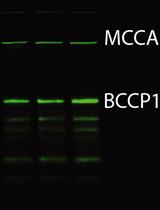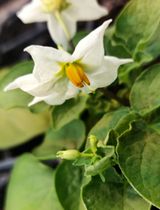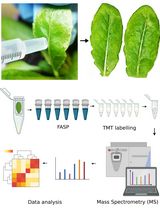- EN - English
- CN - 中文
Agrobacterium-Mediated Transient Gene Expression Optimized for the Bioenergy Crop Camelina sativa
优化农杆菌介导的生物能源作物亚麻籽荠瞬时性基因表达
发布: 2024年04月05日第14卷第7期 DOI: 10.21769/BioProtoc.4964 浏览次数: 1971
评审: Wenrong HeJianyan HuangAnonymous reviewer(s)
Abstract
Camelina sativa, a Brassicaceae family crop, is used for fodder, human food, and biofuels. Its relatively high resistance to abiotic and biotic stresses, as well as being a climate-resilient oilseed crop, has contributed to its popularity. Camelina's seed yield and oil contents have been improved using various technologies like RNAi and CRISPR/Cas9 genome editing. A stable transformation system for protein localization and other cell autonomous investigations, on the other hand, is tedious and time consuming. This study describes a transient gene expression protocol for Camelina sativa cultivar DH55 leaves using Agrobacterium strain C58C1. The method is suitable for subcellular protein localization and colocalization studies and can be used with both constitutive and chemically induced genes. We report the subcellular localization of the N-terminal ER membrane signal anchor region (1–32 aa) of the At3G28580 gene-encoded protein from Arabidopsis in intact leaves and the expression and localization of other known organelle markers. This method offers a fast and convenient way to study proteins in the commercially important Camelina crop system.
Key features
• This method is based on the approach of Zhang et al. [1] and has been optimized for bioenergy crop Camelina species.
• A constitutive and inducible transient gene expression in the hexaploid species Camelina sativa cultivar DH55.
• Requires only 16–18 days to complete with high efficacy.
Graphical overview

Agrobacterium-mediated transient gene expression optimized for Camelina sativa
Background
Camelina sativa, an important Brassicaceae family crop and crop model, is used to make fodder, human food, industrial chemical raw materials, biofuels, and compost to enhance soil properties [2]. It is planted worldwide, particularly in North America, Europe, and Asia, and is also known as large-seeded False Flax seed due to its high level of polyunsaturated fatty acids [3]. Camelina has lately become noted for its potential to be a high-value, climate-resilient oilseed crop owing to its resistance to a variety of abiotic and biotic stresses [4].
Using different technologies like classical breeding, transgenics, and CRISPR/Cas9 genome editing, various genetic improvements in Camelina have been made to increase its seed yield and oil contents and reduce its anti-nutritional glucosinolate content. Stable transformation systems that employ the floral-dip method and in vitro leaf explants are available in Camelina sativa [5]. Nevertheless, the transformation efficiency is very low (i.e., 0.8%–1%) and the method is laborious [6,7]. While an Agrobacteria-mediated infiltration system for rapid and transient gene expression for studying protein localization, protein–protein interaction, etc., has been well established in Nicotiana benthamiana, this technique has had limited applications for other crop species [8]. Hence, with regards to time and labor efficiency, the development of a transient expression system will provide an alternative and convenient way to study genes in Camelina.
Previously, Zhang et al. [1] developed a transient gene expression protocol using different strains of Agrobacteria in the model plant Arabidopsis thaliana, along with seven other plant species: Brassica oleracea, Capsella rubella, Thellungiella salsuginea, T. halophila, Solanum tuberosum, Capsicum annuum, and N. benthamiana. Herein, we modified this protocol for Camelina sativa cultivar DH55. The major modification is the age of the plants, which is younger than that described by Zhang et al. [1], enabling more rapid acquisition of data. In addition, this optimized protocol functions with constitutive and inducible promoters and is suitable for both subcellular localization and colocalization of proteins in Camelina. Using the leaves of 10–12-days-old plants infected with Agrobacterium strain C58C1, we show the subcellular localization of the organelle markers to chloroplasts, peroxisomes, Golgi bodies, and ER [9]. Leaves of 14-day-old plants showed a significantly decreased transformation efficiency, highlighting the benefit of using younger plants for these experiments. We also report the intracellular localization of the N-terminal ER signal (1–32 aa) region of the protein encoded by the At3G28580 gene in intact leaves. This study demonstrates an efficient transient gene expression protocol for Camelina.
Materials and reagents
Biological materials
Camelina sativa cultivar DH55 seeds
Agrobacterium strain C58C1 containing constitutive or chemically inducible plasmid expression constructs.
Plasmids used in this study harbor constructs encoding chloroplast-GFP (CD3-995), peroxisomes-mCherry (CD3-983), Golgi body-mCherry (CD3-967), ER-mCherry (CD3-959) as described in Nelson et al. [9], and Dex-inducible pBAV150 [10] plasmid with DNA encoding the N-terminal (1–32 aa) region of a protein coded by the At3G28580 gene
Reagents
Plastic domes (Hummert International, catalog number: 11-33480) and trays (Hummert International, catalog
number: 11-33010)
Pots 8 cells; width × length × depth: 12.34 × 12.34 × 5.77 cm (T.O. PLASTICS, catalog number: 715352C)
Soil (Berger 60, catalog number: BM2; BM6, mixed in 1:1 ratio)
Yeast extract (Fisher Scientific, catalog number: BP1422-500)
BactoTM peptone (Thermo Fisher Scientific, catalog number: 211677)
Sucrose (Fisher Scientific, catalog number: S5-500)
MgSO4·7H2O (Fisher Scientific, catalog number: 10034-99-8)
NH4Cl (Sigma, catalog number: 12125-02-9)
KCl (Fisher Scientific, catalog number: P217-500)
CaCl2 (Sigma, catalog number: C2661)
FeSO4·7H2O (Sigma, catalog number: F-7002)
NaH2PO4·H2O (JT Baker, catalog number: JTB-3818-05)
Na2HPO4 (Fisher Scientific, catalog number: 7558-79-4)
Glucose (Sigma, catalog number: G7021)
MES (Sigma, catalog number: M8250)
MgCl2·6H2O (Fisher Scientific, catalog number: BP214-500)
Murashige and Skoog medium (Sigma, catalog number: M5519)
Bleach (Clorox Concentrated Germicidal Bleach)
Ethanol (Decon Labs Inc., catalog number: 2701)
Agarose (GOLDBIO, catalog number: 9012-36-6)
Silwet L-77 (Vac-In-Stuff, catalog number: VIS-30)
Tween® 20 (Hoefer, catalog number: 9005-64-5, GR128-500)
Antibiotics: kanamycin sulfate (Kan) and rifampicin (Rif) (Fisher Scientific, catalog number: BP906-5, 13292-46-1, respectively)
NalgeneTM Rapid-FlowTM sterile disposable filter units (Thermo Fisher Scientific, catalog number: 568-0020)
Dexamethasone (Sigma, catalog number: D1756)
Perfluorodecalin (Strem Chemicals, catalog number: 09-5960)
Dimethyl sulfoxide (DMSO) (Sigma, catalog number: D8418)
Agar (Fisher Scientific, catalog number: BP1423-500)
Acetosyringone (Sigma, catalog number: D134406)
Solutions
Washing solution (see Recipes)
Infiltration solution (see Recipes)
Agrobacterium growth media (see Recipes)
30 μM Dexamethasone (Dex) solution with 0.04% Tween-20 (see Recipes)
70% ethanol (see Recipes)
0.1% agar media (see Recipes)
Phosphate buffer (50 mM, 25×, pH 5.5) (see Recipes)
Recipes
Recipes 1, 2, and 3 are adapted from Zhang et al. [1].
Washing solution (1 L)
Reagent Final Concentration Volume MgCl2 (1 M) 10 mM 10 mL Acetosyringone (0.1 M) 100 μM 1 mL ddH2O n/a 989 mL Total n/a 1 L Infiltration solution (1 L)
Note: Water should be added in increments of 100 mL. Allow the solution to mix completely before adding any more water. Murashige and Skoog medium and sucrose will take a substantial volume when fully dissolved. Adjust pH to 6.0 using 1 M KOH; use freshly prepared.
Reagent Final Concentration Quantity or Volume Murashige and Skoog medium 1/4 × (w/v) 1.1 g Sucrose 1% (w/v) 10 g Acetosyringone (0.1 M) 100 µM 1 mL Silwet L-77 0.01% (v/v) 100 μL ddH2O n/a see note Total n/a 1 L Agrobacterium growth media (1 L)
Note: Adjust the pH to 5.5 using 1 M KOH and autoclave the media. After autoclaving, add the filtered induce buffer components. Acetosyringone is prepared in DMSO.
Reagent Final Concentration Quantity or Volume Yeast extract 0.1% (w/v) 1.0 g BactoTM peptone 0.5% (w/v) 5.0 g Sucrose 0.5% (w/v) 5.0 g MgSO4·7H2O 2.03 mM 0.5 g Agarose 1% (w/v) 10.0 g NH4Cl 18.70 mM 1.0 g KCl 2.01 mM 0.15 g CaCl2 90.10 μM 0.01 g FeSO4·7H2O 8.99 μM 0.0025 g ddH2O n/a 889 mL (see note) Induce buffer composition: Phosphate buffer (50 mM, 25×, pH 5.5) 1× 40 mL Glucose (20%, 20×) 1× 50 mL MES (1 M, 50×, pH 5.5) 1× 20 mL Acetosyringone (200 mM, 1,000×) 1× 1 mL Total n/a 1 L 30 μM Dexamethasone (Dex) solution with 0.04% Tween-20 (100 mL)
Note: Dex is prepared in DMSO.
Reagent Final Concentration Volume Dex (30 mM) 30 μM 100 μL (see note) Tween-20 0.04% 40 μL ddH2O n/a 99.86 mL Total n/a 100 mL 70% ethanol (100 mL)
Reagent Final Concentration Volume Ethanol (95%) 70% 73.7 mL ddH2O n/a 26.3 mL Total n/a 100 mL 0.1% agar media (100 mL)
Note: Autoclave the media and stir before it cools.
Reagent Final Concentration Volume Agar 0.1% 100 mg ddH2O n/a 100 mL Total n/a 100 mL (see note) Phosphate buffer (50 mM, 25×, pH 5.5; 100 mL)
Note: Adjust the pH to 5.5 using 1 M KOH.
Reagent Final Concentration Volume NaHPO.HO 48.02 mM 662.7 mg NaHPO 1.98 mM 28.05 mg ddH2O n/a 100 mL Total n/a 100 mL (see note)
Laboratory supplies
Laboratory glassware
Pipette tips: 10 μL, 200 μL, and 1,000 μL (USA Scientific, catalog number: 1111-3700, 1111-1700, 1112-1720)
Black marker (Sharpie Permanent Markers, catalog number: 33861PP)
Kimwipes (Fisher Scientific, catalog number: 06-666A)
15 mL and 50 mL centrifuge tubes (Fisher Scientific, catalog numbers: 14-959-53A, 14-432-22)
9 cm round Petri dishes (Fisher Scientific, catalog number: FB0875712)
1.5 mL microcentrifuge tubes (Fisher Scientific, catalog number: 01-549-746)
1 mL tuberculin syringes without needle (BD Biosciences, catalog number: 309659)
Damp paper towel (Georgia-Pacific, catalog number: P200)
Sterile double-distilled water
Micropipettes 20 μL, 200 μL, and 1 mL (Gilson, catalog number: F144056M, F144058M, F144059M, respectively)
1 L beaker (Pyrex, catalog number: 1000)
Equipment
Cork borer 4 mm diameter
Autoclave (Primus Sterilizer Co. Inc. 1317, catalog number: 09415.1256)
Fisher vortex Genie 2 (Fisher Scientific, catalog number: 12-812)
Plant growth chamber or walk-in growth room with humidity maintained at ≥ 50%. Light intensity should be 135–145 μmols-1·m-2 at soil level
Freezer (-80 °C) (Panasonic VIP Plus, model: MDF-V76VC-PA)
Balance (Mettler Toledo, model: PB1501)
Spectrophotometer (Bio-Mini, model: SHIMADZU)
Laminar flow hood (SterilGARD, model: 3 Advance)
Incubator at 28 °C (VWR, model: 3020)
Analytical balance for weighing chemicals
pH meter (SevenCompact, serial number: B408309625)
Confocal microscope (Zeiss, model: LSM 800)
Software and datasets
Fiji (ImageJ, version 2.15.0, 10/12/2023)
Photoshop (Adobe PS, 22.4.3, 07/19/2021)
Prism v10.1 (GraphPad, 07/01/2023)
BioRender.com online tool
Procedure
文章信息
版权信息
© 2024 The Author(s); This is an open access article under the CC BY-NC license (https://creativecommons.org/licenses/by-nc/4.0/).
如何引用
Kumar, P., Banday, Z. Z., Riley, J. L. and Greenberg, J. T. (2024). Agrobacterium-Mediated Transient Gene Expression Optimized for the Bioenergy Crop Camelina sativa. Bio-protocol 14(7): e4964. DOI: 10.21769/BioProtoc.4964.
分类
植物科学 > 植物分子生物学 > 蛋白质
分子生物学 > 蛋白质 > 表达
您对这篇实验方法有问题吗?
在此处发布您的问题,我们将邀请本文作者来回答。同时,我们会将您的问题发布到Bio-protocol Exchange,以便寻求社区成员的帮助。
提问指南
+ 问题描述
写下详细的问题描述,包括所有有助于他人回答您问题的信息(例如实验过程、条件和相关图像等)。
Share
Bluesky
X
Copy link












